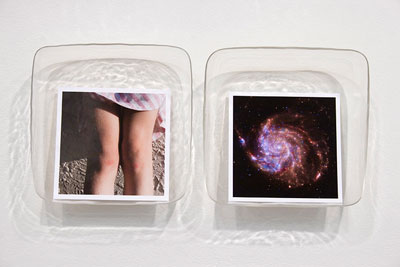
 |
| NOVEMBER THE THIRTEENTH -TWO THOUSAND ELEVEN |

 |
|
 |
|
REVIEW  PHOTO: Courtesy of the artist. If those companies weren’t a scam I would name a star after you. (2011) Posted: 11/13/11 This is just one example. On any given night of television, any visit to the cinema, there is an unrelenting vacuum to draw out our most fragile emotions and wrench them into activation. As a tradition, gut turning soap operas, made their way from day time to prime time and now how many times do I have to see an actress playing a mom die of cancer on Grey’s Anatomy? Later we got a taste for the harder stuff. In reality TV the distance of fiction is supplanted by a smacking embrace of the collectively imagined person-next-door. Every “Biggest Loser” ends with tears; the down-on-their-luck veteran family gets a brand new mansion on Extreme Makeover: Home Edition, on Intervention the intervention with the meth addicted step-son ACTUALLY WORKS and SAVES HIS LIFE. It is within this soggy climate that I want to consider the art of Anna Neighbor. Neighbor’s body of work and her solo show up this month at Vox Populi operate on the forefront on one of our most critical cultural frontiers: sentimentality. Today, sentimentality is commonly invoked as a pejorative; the crutch of bad art (and artists) or the weakness of individuals susceptible to cheap emotions. For example, my SPCA commercial induced hysteria. However this understanding is only the development of the last two hundred years. In its original handle, sentimentality was an epistemological pursuit deriving the path to truth through a reliance on ones senses, feelings, and emotions. It wasn’t until the 19th century, and the prominence of Kantian rationalism, that sentimentality and its virtues were abandoned and scoffed upon in the fashion we know today. In his book “In Defense of Sentimentality” Robert Solomon posits sentimentality as the “appeal to tender feelings” such as “pity, sympathy, fondness, adoration, and compassion.” He argues that sentimentality is not itself a position of ethical, artistic, or rational lack, but has come to be perceived this way through a learned distrust in our emotions and the prominence of abusive outliers. For example, our affinity and “tender feelings” toward infants, itself is not a weakness; using pictures of dead babies to attack women’s reproductive rights, however, is just one extreme case that has come to stigmatize sentimentality and its virtues. It is a complex territory. Sentimentality is efficiently and proactively induced in our culture on a massive scale but is still largely dismissed as a leper within critical discourse. This produces a contradiction for me: As a rational educated adult what do I do about these kitsch pictures of wounded kittens and this terrible song and this commercial and these tears? What do I do with these tears? Neighbor’s work shows me reconciliation and allows me, in part, to trust my tears. In a broad sense her work reclaims the original sentimentality as a virtue of understanding not of vice. She recognizes its capacity for beauty and is brave enough to yield to its potency. Let me give you a feel for what I’m talking about here. In an earlier piece Build the ruin A human proportioned sheet of glass is propped upright by cinderblocks, adorned simply by two overlapping sloppy lip imprints on either face. A sculpture of a photograph of a kiss. Taken objectively, this piece is the metaphor of every Lifetime Channel made-for-tv movie ever made. Two souls separated by an invisible barrier but connected in love. This should be the hallmark of sentimental abuse. But in its literal transparency; its crushing nakedness; we are pushed through the mire of our emotional insecurities to realize that the embodiment of two souls separated by an invisible barrier but connected in love can indeed offer us something true, perhaps eternal, but at the very least beautiful. But lets not get ahead of ourselves. If the stakes I just described (eternal beauty and truth) seem impossibly gigantic its because they are. With this in mind every responsible consideration of the sentimental must also engage ideas of the monumental; the universal. Neighbor’s art is no exception.  PHOTO: Courtesy of the artist Knees from running too fast / Supernovas collapse and explode forming new stars (2011) Heaven is a place where nothing ever happens is the title of her new installation at Vox Populi. I can’t think of anything bigger than heaven. I also can’t think of any place that invokes sentimental notions more readily. This conjunction of the monumental and the sentimental gets echoed bluntly in Knees from running too fast / Supernovas collapse and explode forming new stars a quaint diptych of snapshots mounted in plastic candy dishes. One documents the tender and delicate aftermath of your daughter’s playful misstep the other the GALAXY ENDLESSLY CHURRNING ON EXPLOSIONS OF LIGHT AND ENERGY. There is a pat awareness and cool dry nod in the serving of these titles. As if spelling it out for us, declaring writ as fact, can explain away any notions of sentimentality that we might feel swelling. It is just a place where nothing ever happens. These are just knees. It is just a pic. from an old National Geographic. YET despite the warnings, despite the rationalizing title, despite the laughable universality of my emotions, I cant help it. I am genuinely affected. I am moved to a faith in my sentiments that I have never felt before. Neighbor’s ultimate success is not in getting us to feel; rather it is getting us to feel in the presences of our own rationality. To recognize the cheesiness, understand the rational alternative, and still make a consciences turn back to our emotions. If the ASPCA and Sarah McLachlan made me distrustful of my sentiments Neighbor’s work restored that trust, but with the added appreciation that comes with finding something that once was lost. And for that I am thankful. So go. See her show and remember: its ok to feel. Heaven is a place where nothing ever happens |
| ||||||||||||||||||||||||||||||||